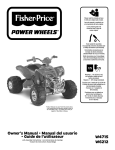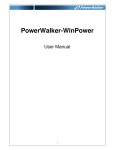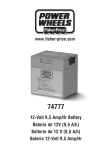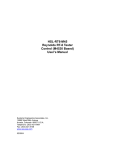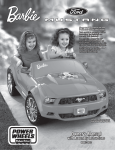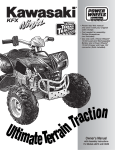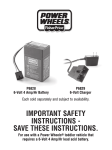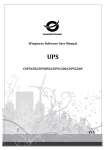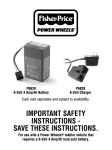Download Fisher-Price W4716 Instruction Sheet
Transcript
• Please read this manual and save it with your original sales receipt. • Tools needed for assembly: two assembly wrenches (included) and a Phillips Screwdriver (not included). • Use only with a Power Wheels® 12 Volt Lead-Acid Rechargeable Battery and a Power Wheels® 12 Volt Charger (both included). Owner's Manual with Assembly Instructions For Models W4715, W4716 and W5540 IMPORTANT INFORMATION ELECTRICAL HAZARD DANGER • To prevent electric shock, do not immerse in water; wipe clean with a damp cloth. WARNING • Battery can fall out and injure a child if vehicle tips over. Always use battery retainer. • PREVENT FIRE - Never modify the electrical system. Alterations could cause a fire resulting in serious injury and could also ruin the electrical system. - Use of the wrong type battery or charger could cause a fire or explosion resulting in serious injury. - Use of Power Wheels® components in products other than Power Wheels® vehicles could cause overheating, fire or explosion. • The battery must be handled by adults only. The battery is heavy and contains sulfuric acid (electrolyte). Dropping the battery could result in serious injury. • Never allow children to charge the battery. Battery charging must be done by adults only. A child could be injured by the electricity involved in charging the battery. • Read the safety instructions on the battery. • Examine the battery, charger and their connectors for excessive wear or damage each time you charge the battery. If damage or excessive wear is detected, do not use the charger or the battery until you have replaced the worn or damaged part. • HOT motors. Handle carefully. RIDING HAZARD WARNING • Prevent Injuries and Deaths • Direct Adult Supervision Required. • Never Ride at Night. • Keep Children Within Safe Riding Areas. These areas must be: - Away from swimming pools and other bodies of water to prevent drownings. - Generally level to prevent tipovers. - Away from steps, steep inclines, cars, roads and alleys. • Riding Rules Make sure children know and follow these rules for safe driving and riding. - Always sit on the seat. - Always wear shoes. - Only 1 (one) rider at a time. 00989pr-1056 2 IMPORTANT INFORMATION • Read this manual carefully for important safety information and operating instructions before using your vehicle. Keep this manual for future reference, as it contains important information. • The vehicle is designed for use on grass, asphalt, and other hard surfaces; on generally level terrain; and by children 3 years of age and older. Do not exceed the maximum weight capacity of 65 lbs (29,5 kg). • Your new vehicle requires adult assembly. Please set aside at least 30 minutes for assembly. • Use this vehicle ONLY outdoors. Most interior flooring can be damaged by riding this vehicle indoors. Fisher-Price® will not be responsible for damage to the floor if the vehicle is used indoors. • You must charge your battery for 18-30 hours before you use your vehicle for the first time. We recommend charging your battery before beginning assembly. Please see the Battery Charging section for detailed instructions. • The battery charger is not a toy. • Do not short circuit the battery. • Adults Note: Regularly examine the charger for damage to the cord, plug, housing or other parts that may result in the risk of fire, electric shock or injury. In the event of any damage, do not use the charger until the damage has been properly repaired. • Your Power Wheels® 12 volt battery is equipped with a built-in thermal fuse. The thermal fuse is a self-resetting safety device which automatically “trips” and shuts down operation of the vehicle if the vehicle is overloaded or the driving conditions too severe. Once a fuse has “tripped”, remove your foot from the pedal and wait approximately 25 seconds before operating the vehicle again. To avoid repeated automatic shut-downs, avoid severe driving conditions. • If a thermal fuse in a battery continually trips under normal driving conditions, please contact your local Power Wheels® Authorized Service Center. • To prevent damaging the motors and gears, teach your child to stop the vehicle before switching direction. • If you have any questions about your Power Wheels® vehicle, please call our toll-free service lines at 1-800-348-0751. Trained customer service representatives are available to take your call in English or French. Habla Español? Si usted tiene alguna pregunta ó necesita asistencia llame gratis 1-800-348-0755 para los Estados Unidos. Tenemos representantes que hablan español para atender su llamada. • For your convenience, Power Wheels® maintains an independently owned and operated Authorized Service Center Network with more than 300 authorized service centers nationwide. Our authorized service centers will repair or replace parts under warranty at no extra charge, and can perform non-warranty repairs for a minimal charge. To find the authorized service center nearest you, please visit us online at www.powerwheels.com or call 1-800-348-0751. • Please visit us online at www.powerwheels.com to register your vehicle. 3 00989pr-1056 ASSEMBLED PARTS • If you experience a problem with this product, please call us at 1-800-348-0751, rather than return this product to a store. • Please identify all parts before assembly and save all packaging material until assembly is complete to ensure that no parts are discarded. • Metal parts have been coated with a lubricant to protect them during shipment. Wipe all metal parts with a paper towel to remove any excess lubricant. Vehicle Handlebar 12 Volt Battery Seat Rear Axle 2 Rear Wheel Drivers 12 Volt Charger Plate Steering Column Cap Front Clip Brush Guard 2 Front Wheels 4 Wheel Covers 2 Bushings 2 Hand Grips 2 Rear Wheels 4 Hubcaps 2 Wrenches Parts Not Shown: Decorative Label Sheet and Instructions #8 x 3/4" (1,9 cm) Screw - 4 #8 x 2" (5 cm) Screw - 2 7/16" (1,1 cm) Washer - 2 3/8" (1 cm)-16 Hex Nut - 3 Fasteners Shown Actual Size For your convenience, we included extra fasteners! Note: Tighten and loosen all screws with a Phillips screwdriver. Do not over-tighten the screws. 00989pr-1056 4 ASSEMBLED PARTS Note: Some parts shown are assembled on both sides of the vehicle. Fasteners not shown. 5 00989pr-1056 BATTERY CHARGING • Make sure you charge the battery for at least 18 hours using the enclosed Power Wheels® 12 volt charger before operating your vehicle for the first time. Charge the battery for at least 14 hours after each use of the vehicle. Never charge the battery longer than 30 hours. Failure to follow these instructions may damage your battery and will void your warranty. • Use only a Power Wheels® 12 volt charger with “12V” connector (input 120 VAC, 60Hz, with an output of 12 VDC) to charge your Power Wheels® 12 volt battery. ELECTRICAL HAZARD WARNING • Battery can fall out and injure a child if vehicle tips over. Always use battery retainer. • PREVENT FIRE - Never modify the electrical system. Alterations could cause a fire resulting in serious injury and could also ruin the electrical system. - Use of the wrong type battery or charger could cause a fire or explosion resulting in serious injury. - Use of Power Wheels® components in products other than Power Wheels® vehicles could cause overheating, fire or explosion. • The battery must be handled by adults only. The battery is heavy and contains sulfuric acid (electrolyte). Dropping the battery could result in serious injury. • Never allow children to charge the battery. Battery charging must be done by adults only. A child could be injured by the electricity involved in charging the battery. • Read the safety instructions on the battery. • Examine the battery, charger and their connectors for excessive wear or damage each time you charge the battery. If damage or excessive wear is detected, do not use the charger or the battery until you have replaced the worn or damaged part. Charger Connector • Plug the charger connector into the battery socket. Plug the charger into a standard wall outlet. Notes: - Battery must be upright while charging. - If power flow to the wall outlet is controlled by a switch, make sure the switch is “ON”. - Use the charger only in a wall outlet. Do not plug the charger into a ceiling outlet. • Before charging the battery, examine the battery case for cracks and other damage which may cause sulfuric acid (electrolyte) to leak during the charging process. If damage is detected, do not charge the battery or use it in your vehicle. Battery acid is very corrosive and can cause severe damage to surfaces it contacts. • You do not need to remove the battery from your vehicle to recharge it. • Do not place the battery on a surface (such as kitchen counter tops) which could be damaged by the acid contained inside the battery. Take precautions to protect the surface on which you place your battery. • Charge the battery in a well ventilated area. • Once the battery is charged, disconnect the charger from the battery. Unplug the charger from the wall outlet. Refer to the Battery Installation section for instructions to install your battery. If your battery is already installed in your vehicle, simply re-connect the motor harness connector to the battery. CAUTION Use the charger in dry locations only. 00989pr-1056 6 ASSEMBLY Motor Assembly WARNING Rear Wheel (Pegged Side First) Children can be harmed by small parts, sharp edges and sharp points in the vehicle's unassembled state, or by electrical items. Care should be taken in unpacking and assembly of the vehicle. Children should not handle parts, including the battery, or help in assembly of the vehicle. Rear Wheel Driver (Slotted Side Down) 3 Rear Wheel Driver (Slotted Side Out) Wheel Cover (Indented Side Out) • Slide a rear wheel driver, slotted side out, onto the rear axle. Make sure the rear wheel driver fits into the pins in the motor assembly inside the vehicle. • Locate the other rear wheel. Slide the wheel, flat side first, onto the rear axle. Make sure the slots on the rear wheel driver fit onto the pegs on the wheel. • Slide a wheel cover, indented side out, onto the rear axle. Rear Wheel (Indented Side Down) Wheel Cover (Indented Side Down) 1 • Slide a wheel cover, indented side down, onto the rear axle. • Locate a rear wheel. Slide the wheel, indented side down, onto the rear axle. • Slide a rear wheel driver, slotted side down, onto the rear axle. Fit the slots on the rear wheel driver onto the pegs on the wheel. Wrench 3 8 / " (1 cm) -16 Hex Nut 4 Motor Assembly • Fit a 3/8" (1 cm) -16 hex nut onto the end of the rear wheel assembly. • Tighten the hex nut on of the rear wheel assembly with the wrench. Hint: An extra wrench has been provided to hold the hex nut on the other side of the rear axle while tightening the hex nut on the other side. • You may need the help of another adult to hold the rear wheel assembly while you tighten the hex nut. Rear Axle Assembly 2 BOTTOM VIEW • Position the vehicle upside down. • Slide the rear axle assembly through the hole in the back end of the vehicle, as shown. Make sure the rear wheel driver fits into the pins in the motor assembly inside the vehicle. 7 00989pr-1056 ASSEMBLY Steering Column Connector Steering Column Cap 7 5 BACK VIEW • Fit the steering column cap onto the end of the steering column. • Insert a #8 x 3/4" (1,9 cm) screw through the large opening in the steering column cap and into the hole in the steering column. Tighten the screw. • Turn the vehicle upright. • Fit the handlebar steering column and connector down through the large opening in the front end of the vehicle. Steering Column Plate 6 BOTTOM VIEW • While holding the handlebar in place, carefully turn the vehicle over. Check to be sure the steering column fits through the hole in the steering linkage. 00989pr-1056 8 • Slide the plate under the steering column, as shown. • Insert a #8 x 3/4" (1,9 cm) screw into the plate and tighten. 8 ASSEMBLY Front Axle Washer Front Wheel (Flat Side First) Bushing (Ring End First) Wheel Cover (Indented Side Out) 9 Front Clip • Slide a 7/16" (1,1 cm) washer onto the front axle. • Slide a bushing, ring end first, onto the front axle. • Locate a front wheel. Slide the wheel, flat side first, onto the front axle. • Slide a wheel cover, indented side out, onto the front axle. • Repeat this procedure on the other side of the vehicle. 12 FRONT VIEW • Fit the front clip onto the front of the vehicle, as shown. Hint: The front clip may be factory assembled. 3 8 / " (1 cm) -16 Hex Nut Wrench 10 13 Brush Guard 3 8 • Fit a / " (1 cm) - 16 hex nut onto each end of the front axle. Tighten both hex nuts with the wrench. • Fit the brush guard onto the front clip. • Insert two #8 x 3/4" (1,9 cm) screws into the lower holes in the brush guard and tighten. Hubcaps Hubcaps 11 • “Snap” a hubcap onto the center of each wheel cover. • Turn the vehicle upright. 9 00989pr-1056 ASSEMBLY A Drive Buttons Seat B 14 • Insert two #8 x 2" (5 cm) screws into the upper holes in the brush guard and tighten. Hand Grip Hand Grip 17 • Fit the tab at the front of the seat into the slot below the drive buttons A . • “Snap” the tab at the back of the seat into the slot near the rear of the vehicle B . 15 Decorative Labels • Please refer to the Decoration instructions included on a separate sheet to apply decorative labels to your product. • Before applying the labels, wipe the surface of the vehicle with a clean, dry cloth to remove any dust or oils. • Place the labels exactly as shown in the illustrations. For best results, avoid repositioning a label once it has been applied to the vehicle. • After applying a label, rub the label firmly with a clean, dry cloth to make sure the label is adhered to your vehicle. Start at the center of a label, and smooth towards the outer edges to remove air bubbles. BACK VIEW • Fit both hand grips on the ends of the handlebar. Hint: If it is difficult to slide a hand grip onto the handlebar, moisten the inside of the grip with water. Drive Buttons Connector 16 • Locate the opening below the drive buttons. • Reach into the opening and pull the high speed connector out through the opening. • Refer to page 13 for information on high speed operation. 00989pr-1056 10 BATTERY INSTALLATION IMPORTANT! Use only a Power Wheels® 12 volt battery. Use of any other battery will damage your vehicle. Battery Retainer Seat 1 3 • Press the tab under the back edge of the seat and lift to remove the seat. • Carefully lower the battery into the battery compartment. The battery retainer slides over the battery to secure it. A Power Wheels® 12 Volt Battery Drive Buttons Seat Battery Retainer B Motor Harness Connector 4 2 • Lift the battery retainer to access the battery compartment. • Place the battery upright in the battery compartment. • Plug the motor harness connector into the battery. Push firmly. • Fit the tab at the front of the seat into the slot below the drive buttons A . • “Snap” the tab at the back of the seat into the slot near the rear of the vehicle B . 11 00989pr-1056 SAFE DRIVING RULES Before children use this vehicle, an adult should carefully evaluate the driving area as well as the child’s skill level and ability to drive the vehicle safely. Teach appropriate safety rules to your child before allowing operation of this vehicle. These rules should also be reviewed with other playmates who want to drive the vehicle. • A child who is not sitting on the seat could fall off, cause a tip over or block the driver’s view. • Only operate the vehicle in the daytime in a well-lit area. • Driving near steep inclines can cause: - The vehicle to gain unsafe speed, even if the pedal is released to stop. - The vehicle to tilt and tip over - The wheels to lose traction, causing the vehicle to slip. - The vehicle could roll backwards at an unsafe speed. • Never put anything near any moving parts. Rotating parts, such as motors, gear boxes and wheels, can snag fingers, hair, etc., causing serious injury. • Do not allow operation of the vehicle when it is on its side or in an upside-down position. • Do not operate the vehicle near flammable vapors (gasoline, paint thinner, acetone, liquid wax, etc.). The vehicle’s electrical switches, like most electrical switches, emit an internal spark when first turned on or turned off, which could cause an explosion or fire. • To prevent unsupervised use of the vehicle, disconnect the motor harness from the battery when the vehicle is not in use. RIDING HAZARD WARNING • Prevent Injuries and Deaths • Direct Adult Supervision Required. • Never Ride at Night. • Keep Children Within Safe Riding Areas. These areas must be: - Away from swimming pools and other bodies of water to prevent drownings. - Generally level to prevent tipovers. - Away from steps, steep inclines, cars, roads and alleys. • Riding Rules Make sure children know and follow these rules for safe driving and riding. - Always sit on the seat. - Always wear shoes. - Only 1 (one) rider at a time. Use vehicle on generally level ground ONLY! 00989pr-1056 12 VEHICLE OPERATION As assembled, your vehicle is ready to roll in low speed (21/2 mph/4 km/h, maximum). After your child has mastered the basic skills of driving and understands the rules for safe driving, it’s time to remove the high speed lock-out screw to allow the vehicle to operate in low or high speed. See the instructions in this section to connect the high speed connectors and operate the vehicle at high speed. Beginner Use - Low Speed Drive Advanced Use - High Speed Drive Buttons • Press a DRIVE button below the handlebar. • Press the foot pedal. The vehicle goes forward or in reverse at a maximum of 2½ mph/4 km/h. • Help your child practice steering to learn how far and how quickly to turn the handlebar when driving. • Remove the seat to access the high speed hook-up. • Locate the high speed connector in the opening inside the front end of the vehicle. Plug the high speed connector (with yellow tag) into the matching connector (with yellow tag). • Re-assemble the seat. • To prevent operation of the vehicle in high-speed, simply disconnect the high speed connectors. IMPORTANT! To prevent damaging the motors and gears, teach your child to stop the vehicle before switching direction. STOP! Twist Grip to Activate High Speed • Your vehicle has a patented, electronic braking system that automatically stops the vehicle when your child’s foot lifts from the pedal. • Make sure your child is comfortable with steering the vehicle and automatically knows how to stop. • Turn the right grip to shift the vehicle into high speed. The vehicle drives forward at a maximum of 5 mph/8 km/h. • Help your child practice steering to learn how far and how quickly to turn the handlebar when driving forward in high speed. 13 00989pr-1056 BATTERY CARE VEHICLE CARE If a battery leak develops, avoid contact with the leaking acid and place the damaged battery in a plastic bag. See next section for proper disposal. If acid comes in contact with skin or eyes, flush with cool water for at least 15 minutes and call a physician. If acid is internally ingested, give water, milk of magnesia or egg whites immediately. Never give emetics or induce vomiting. Call a physician. • Do not allow the battery to run down completely before charging. • Charge the battery before storing the vehicle, and at least once per month, even if the vehicle has not been used. • Charge the battery after each use, regardless of how long the vehicle was used. • Leaving the battery in a discharged condition will ruin it. • Always remove an exhausted battery from the vehicle. Battery leakage and corrosion can damage the vehicle. • Do not store the battery in temperatures above 75° F or below -10° F. • Check all screws and their protective coverings regularly and tighten as required. Check plastic parts on a regular basis for cracks or broken pieces. • During snowy or rainy weather, the vehicle should be stored inside or under a protective cover. • Avoid operating the vehicle in wet or snowy conditions. Water or moisture in the motors or electrical switches can cause them to corrode, and could cause switch or motor failure. • Avoid operating the vehicle on sand, loose dirt or gravel. Sand, loose dirt or gravel in the motors or electrical switches can cause them to jam, and could cause switch or motor failure. • The vehicle can be wiped down with a soft, dry cloth. For a shiny finish, you can wipe plastic parts with a non-wax furniture polish applied to a soft cloth. Do not use automotive wax. Do not use soap and water or spray the vehicle with a hose. • To ensure your vehicle stays in good operating order, we recommend you periodically have your vehicle checked by a Power Wheels® authorized service center. BATTERY DISPOSAL LIMITED WARRANTY • Your Power Wheels® battery is a non-spillable, sealed lead-acid battery. It must be recycled or disposed of in an environmentally sound manner. • Do not dispose of a lead-acid battery in a fire. The battery may explode or leak. • Do not dispose of a lead-acid battery in your regular, household trash. The incineration, landfilling or mixing of sealed lead-acid batteries with household trash is prohibited by law in most areas. • Protect the environment by not disposing of this product with household waste (2002/96/EC). Check your local authority for recycling advice and facilities (Europe only). • Return an exhausted battery to a federal or state approved lead-acid battery recycler, such as a Power Wheels® authorized service center or a local seller of automotive batteries. Contact your local waste management officials for other information regarding the environmentally sound collection, recycling and disposal of lead-acid batteries. If you live in the State of Florida or the State of Minnesota, it is prohibited by law for anyone to throw away lead-acid batteries in the municipal waste stream. 00989pr-1056 Bumper-to-Bumper* Limited Warranty *One year limited warranty from the date of purchase on the Power Wheels® vehicle. Six month limited warranty on the 12 volt battery. For the original purchaser, this one year limited warranty covers the Power Wheels® ride-on vehicle (purchased from Power Wheels®) against defects in materials and workmanship. The six month limited warranty applies only to the 12 volt battery included by Power Wheels® with the original purchase of the vehicle. This warranty covers normal use and does not cover the Power Wheels® vehicle or battery if damaged by unreasonable use, neglect, accident, abuse, misuse, improper service or other causes not arising out of defects in materials or workmanship. Evidence of any attempt at consumer repair will void this warranty. THIS WARRANTY DOES NOT COVER, AND IS INTENDED TO EXCLUDE, ANY LIABILITY ON THE PART OF POWER WHEELS®, WHETHER UNDER THIS WARRANTY OR IMPLIED BY LAW FOR ANY INDIRECT OR CONSEQUENTIAL DAMAGES FOR BREACH OF WARRANTY. SOME STATES DO NOT ALLOW THE EXCLUSION OR LIMITATION SO THIS LIMITATION MAY NOT APPLY TO YOU. Should you need service or assistance with your vehicle during the warranty period, do not return the vehicle to the store. Power Wheels® has provided a nationwide network of authorized service centers. If there is not an authorized service center in your area, please visit us on-line at www.powerwheels.com or call Consumer Relations for information, 1-800-348-0751. This warranty gives you specific legal rights, and you may also have other rights which may vary from state to state. PLEASE SAVE YOUR ORIGINAL SALES RECEIPT. 14 FCC Statement ICES-003 United States Only This equipment has been tested and found to comply with the limits for a Class B digital device, pursuant to Part 15 of the FCC Rules. These limits are designed to provide reasonable protection against harmful interference in a residential installation. This equipment generates, uses and can radiate radio frequency energy and, if not installed and used in accordance with the instructions, may cause harmful interference to radio communications. However, there is no guarantee that interference will not occur in a particular installation. If this equipment does cause harmful interference to radio or television reception, which can be determined by turning the equipment off and on, the user is encouraged to try to correct the interference by one or more of the following measures: • Reorient or relocate the receiving antenna. • Increase the separation between the equipment and receiver. • Connect the equipment into an outlet on a circuit different from that to which the receiver is connected. • Consult the dealer or an experienced radio/TV technician for help. Note: Changes or modifications not expressly approved by the manufacturer responsible for compliance could void the user’s authority to operate the equipment. This device complies with Part 15 of the FCC Rules. Operation is subject to the following two conditions: (1) This device may not cause harmful interference and (2) this device must accept any interference received, including interference that may cause undesired operation. • This Class B digital apparatus complies with Canadian ICES-003. • Operation is subject to the following two conditions: (1) this device may not cause harmful interference and (2) this device must accept any interference received, including interference that may cause undesired operation. NMB-003 • Cet appareil numérique de la classe B est conforme à la norme NMB-003 du Canada. • L’utilisation de ce dispositif est autorisée seulement aux conditions suivantes : (1) il ne doit pas produire de brouillage et (2) l’utilisateur du dispositif doit être prêt à accepter tout brouillage radioélectrique reçu, même si ce brouillage est susceptible de compromettre le fonctionnement du dispositif. 15 00989pr-1056 PROBLEMS AND SOLUTIONS GUIDE IMPORTANT! If you experience a problem with your vehicle, first check the Problems and Solutions Guide below. If you still experience a problem, please contact Power Wheels® Consumer Relations, or your local Power Wheels® authorized service center. PROBLEM Vehicle does not run POSSIBLE CAUSE Undercharged battery SOLUTION Charge the battery. A new battery should have been charged for at least 18 hours before using the vehicle for the first time. After first-time use, recharge the battery for at least 14 hours after each use. Never charge the battery longer than 30 hours. Check all connectors. Make sure the charger connector is plugged into the battery, and that the charger is plugged into the wall. Make sure power flow to the wall outlet is “ON”. 00989pr-1056 Charger is not working There is no sure way to tell if your charger is working unless you have a volt meter. If you suspect there is a problem with your charger, contact your local Power Wheels® authorized service center. They can test your charger for you. Tripped thermal fuse The built-in thermal fuse may “trip” and shut down operation of the vehicle if the vehicle is overloaded or the driving conditions too severe. Once a fuse has “tripped”, remove your foot from the pedal and wait approximately 25 seconds before operating the vehicle again. To avoid repeated automatic shutdowns, do not overload the vehicle by exceeding the 65 lbs (29,5 kg) maximum weight capacity or by towing anything behind the vehicle. Do not drive up hills or run into fixed objects, which can cause the wheels to stop spinning while power is still being supplied to the motors. If a thermal fuse continually trips, contact your local Power Wheels® authorized service center. Loose wire or loose connectors Check all wires and connectors. Make sure the motor harness connector is plugged into the battery, and that there are no loose wires around the motors. Dead battery If your battery is old or if you have not followed Battery Care instructions, your battery may be dead. If you are unsure whether or not the battery is dead, you can have it tested at your local Power Wheels® authorized service center. Electrical switch damage The electrical switches can become corroded due to exposure to water or moisture, or can jam due to loose dirt, sand or gravel. Contact your local Power Wheels® authorized service center for diagnosis and repair. Motor damage Contact your local Power Wheels® authorized service center for diagnosis and repair. 16 PROBLEMS AND SOLUTIONS GUIDE PROBLEM Vehicle was running but suddenly stopped Short run time (Less than 1 - 3 hours per charge) POSSIBLE CAUSE SOLUTION Loose wire or loose connectors Check all wires and connectors. Make sure the motor harness connector is plugged into the battery, and that there are no loose wires around the motors. Tripped thermal fuse The built-in thermal fuse may “trip” and shut down operation of the vehicle if the vehicle is overloaded or the driving conditions too severe. Once a fuse has “tripped”, remove your foot from the pedal and wait approximately 25 seconds before operating the vehicle again. To avoid repeated automatic shutdowns, do not overload the vehicle by exceeding the 65 lbs (29,5 kg) maximum weight capacity or by towing anything behind the vehicle. Do not drive up hills or run into fixed objects, which can cause the wheels to stop spinning while power is still being supplied to the motors. If a thermal fuse continually trips, contact your local Power Wheels® authorized service center. Undercharged battery Charge the battery. A new battery should have been charged for at least 18 hours before using the vehicle for the first time. After first-time use, recharge the battery for at least 14 hours after each use. Never charge the battery longer than 30 hours. Check all wires and connectors. Make sure the charger connector is plugged into the battery, and that the charger is plugged into the wall. Make sure power flow to the wall outlet is “ON”. Overcharged battery Do not charge the battery longer than 30 hours. If you suspect that your battery is damaged as a result of overcharging, contact your local Power Wheels® authorized service center. They can test your battery for you. Battery is old and will not accept full charge Even with proper care, a rechargeable battery does not last forever. Average battery life is 1 to 3 years depending on vehicle use and use conditions. Replace the battery with a new Power Wheels® 12 volt rechargeable battery. Do not substitute parts. Tripped thermal fuse The built-in thermal fuse may “trip” and shut down operation of the vehicle if the vehicle is overloaded or the driving conditions too severe. Once a fuse has “tripped”, remove your foot from the pedal and wait approximately 25 seconds before operating the vehicle again. To avoid repeated automatic shutdowns, do not overload the vehicle by exceeding the 65 lbs (29,5 kg) maximum weight capacity or by towing anything behind the vehicle. Do not drive up hills or run into fixed objects, which can cause the wheels to stop spinning while power is still being supplied to the motors. If a thermal fuse continually trips, contact your local Power Wheels® authorized service center. 17 00989pr-1056 PROBLEMS AND SOLUTIONS GUIDE v PROBLEM Vehicle runs sluggishly POSSIBLE CAUSE Undercharged battery SOLUTION Charge the battery. A new battery should have been charged for at least 18 hours before using the vehicle for the first time. After first-time use, recharge the battery for at least 14 hours after each use. Never charge the battery longer than 30 hours. Check all connectors. Make sure the charger connector is plugged into the battery, and that the charger is plugged into the wall. Make sure power flow to the wall outlet is “ON”. Vehicle runs in low speed, but does not run in high speed. Battery needs charging Be sure to charge the battery after each use. Battery is old and will not accept full charge Even with proper care, a rechargeable battery does not last forever. Average battery life is 1 to 3 years depending on the vehicle use and use conditions. Replace the battery with a new Power Wheels® 12 volt rechargable battery. Do not substitute parts. Vehicle is overloaded Make sure you do not overload the vehicle by allowing more than one rider at one time, by exceeding the 65 lbs (29,5 kg) maximum weight capacity, or by towing objects behind the vehicle. Driving conditions are too stressful Restrict your child's driving to areas that are generally level only. High speed lock-out not disconnected The vehicle was pre-set to run only in low speed. To allow the vehicle to run in low and high speed, you must connect the High Speed connectors. Follow the instructions on page 13. Note: The high speed connectors must be joined to use the high speed grip. Please note: The vehicle is designed to operate in low speed only in reverse . 00989pr-1056 18 PROBLEMS AND SOLUTIONS GUIDE PROBLEM POSSIBLE CAUSE SOLUTION When the foot pedal is pressed one rear wheel spins Operation of vehicle in low speed It is possible that only one rear wheel may spin when both rear wheels are raised off the ground and the vehicle is in low speed. This does not necessarily indicate a problem. Check for proper operation of the drive system by raising the rear wheels off the ground and pressing the foot pedal. If only one rear wheel spins, carefully press your hand on the spinning wheel to slow it down. The other rear wheel should begin to spin. If the other rear wheel does not begin to spin, there may be a problem with the vehicle. Contact your local Power Wheels® authorized service center for diagnosis and repair. Sometimes the vehicle doesn’t run, but other times it does Loose wire or connector Check all wires around the motors and all connectors to make sure they are tight. Motor or electrical switch damage Contact your local Power Wheels® authorized service center for diagnosis and repair. Loose wire or connector Check all wires around the motors and all connectors to make sure they are tight. “Dead Spot” on motor Contact your local Power Wheels® authorized service center for diagnosis and repair. Damaged battery Contact your local Power Wheels® authorized service center for diagnosis and repair. Child is switching between FORWARD and REVERSE without stopping Teach your child to stop the vehicle before switching direction. Loud clacking or grinding noise from a motor-gearbox Broken gears Contact your local Power Wheels® authorized service center for diagnosis and repair. Charger gets warm during use It is normal for some chargers to get warm during use and is not reason for concern. No action required. When the foot pedal is pressed, the vehicle won’t run without a push Battery's thermal fuse constantly "trips", but the vehicle is not overloaded nor the driving conditions too severe If your charger does not get warm during use, it does not mean that it is not working properly. Battery makes a sizzling or gurgling noise when charging It is normal for some batteries to make noise and swell slightly while charging and is not reason for concern. No action required. If your battery does not make noise or swell slightly during charging, it does not mean that it is not accepting the charge. 19 00989pr-1056 Before first-time use, you must charge the battery 18 hours! Charge the battery immediately after each use. Charge the battery once a month, even if the vehicle is not used or stored. Do not return your vehicle to the store! We're a toll-free phone call away, and we can help. If you are missing parts or need assistance, please call: 1-800-348-0751 Or contact your local independently owned and operated Power Wheels Authorized Service Center. For the location nearest you, visit us on-line at www.powerwheels.com. ® Fisher-Price, Inc., a subsidiary of Mattel, Inc., East Aurora, NY 14052 U.S.A. ©2011 Mattel, Inc. All Rights Reserved. ® and ™ designate U.S. trademarks of Mattel, Inc. PRINTED IN MEXICO 00989pr-1056





















